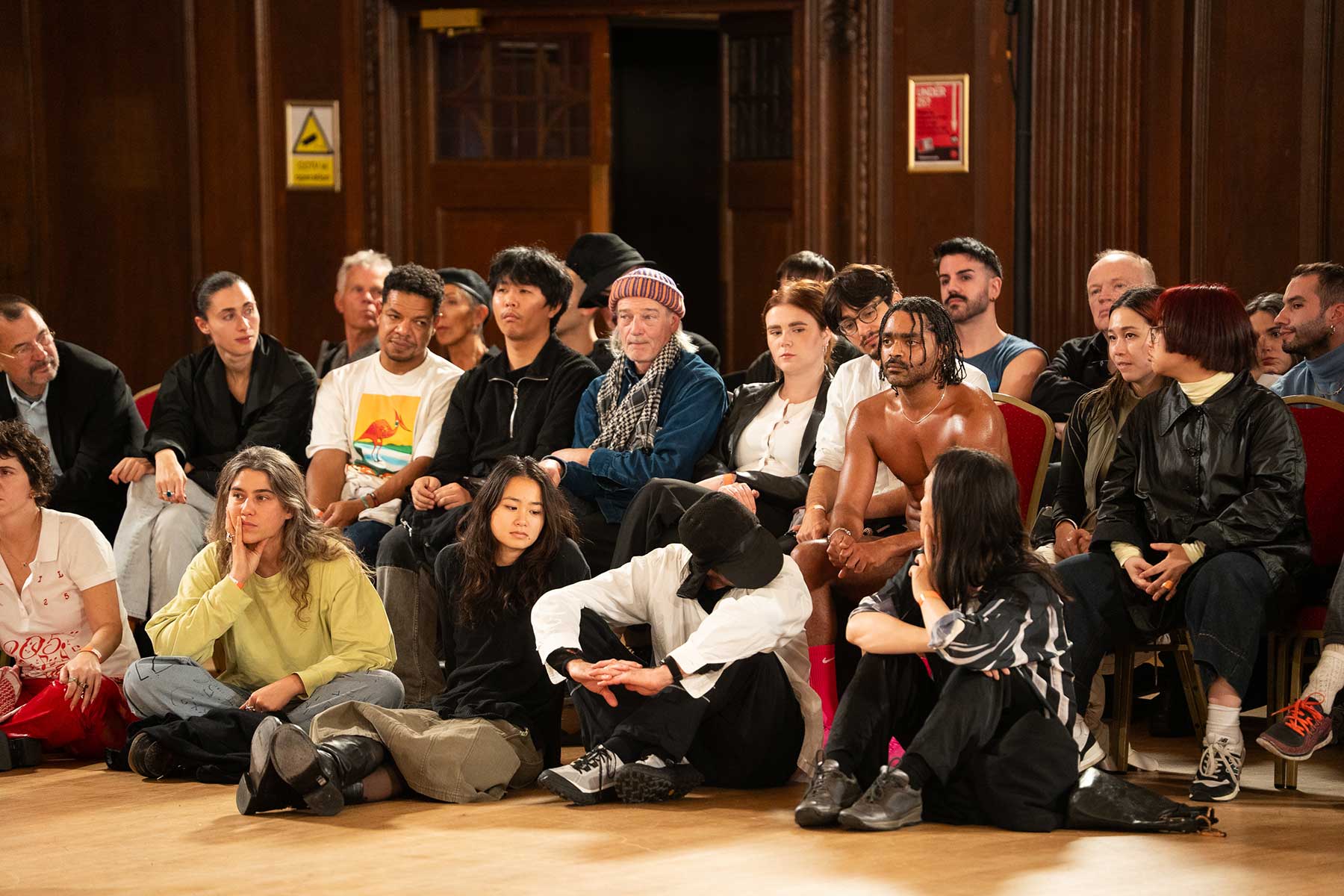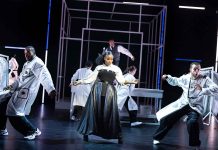
Set in Porchester Hall, a lavish 1920’s art-deco ballroom, the Brazilian artists Davi Pontes and Wallace Ferreira presented the third instalment of their trilogy Repertório N.1.
An edgy crowd filled their seats creating a rectangular parameter around the space. On stage were two smaller black stages, where audience members were encouraged to sit on. Adorned with red velvet curtains and luminescent chandeliers, the space was open, inviting and alive. No theatrical lighting, no music playing, only the audience’s chatter, laughter and movement in their chairs.
The audience’s merriment was arrested by a black, male performer striding across the space to take a stand; fully nude, except for bright fuchsia Nike trainers and socks. Slowing scanning the audience – was he looking for safety, acceptance, reassurance of a friend? Or was he just present, resilient, resolute – a reclamation of his space, his time and his autonomy over his body.
As he stood there (his nakedness reminiscent of the colonial human zoos of the late nineteenth century), I felt a level of discomfort rise in my stomach, as the audience’s eyes enveloped the performer. Those feelings of fetishization and being hyper aware of my black body, always being surveyed, came to the fore.
There was no lighting shift or music track, just breathless silence and intense eye contact – the black, male body revealed and consumed. The audience reactions ranged from visible discomfort, intrigue, arousal, and suppressed laughter. The performer was joined by another black performer, she/they were naked in Nikes and socks. Both performers held the audience’s attention: static classical art models with furtive eyes – daring the audience to look and really see them.
Their first movement was a bicep curling, muscle man pose, in opposition to their bevelled feet. They were deconstructing gender norms: both performers possessing both feminine and masculine energies. The dancers explored an array of dynamic poses which explored reaching, offering, and confronting gestures. Poses which were demure, coquettish, and sculptural. At one point coming together to form a cupid-like love heart.
One of Repertório N.1 strengths is the interrogation of what physically and emotionally is on display for the viewer, versus what is hidden and not for mass appeal. There was a sense of neutrality produced by the performers; they didn’t over dramatized, or seek approval, they were purely present in their truth.
The dancers provoked the audience by breaking the fourth wall and Invading their space. Sliding, wiggling and jostling to sit and stand amongst the crowd. Pontes and Wallace often reminded me of legendary tour de force Grace Jones, exhibiting her power and bravery.
The action quickened and the poses became more extreme. The performers morphed into Vogue fashion models, animated and lit up on an accelerated billboard. A heavy use of heightened repetition interrupted the once monotone tempo. This repetition was exemplified by a punctuated zigzagging, stomping, piston-like step, which locomoted around the space. I must confess my bias.
I am not a huge fan of repetition and vocabulary that relies on just a few movements. So at times I was disconnected from the piece and its message. However, this did allow me the space to engage with the audience, which made me question: who is really being watched at any time? What do you perceive when you look at another human being? What labels are you putting on them and why?
Historically, the black, form has been deemed as hypermasculine, oversexualised, brutally abused, coveted and used as labour – all due to racist stereotypes, which are still prevalent and perpetuated in contemporary society. Repertório N.1 investigates this prejudice in a silent and embodied protest; suggesting that the viewer see all parts of them, as they really are.
One stand out moment was when a dancer gestured at a female audience members handbag. However, the women tried to touch the dancers body on two occasions, from which the dancer moved his position to avoid the unwanted touch. Finally she got the message, placing the bag in his hand, enabling him to dance with it. In this interaction I remembered how people often thought my body was constantly available for their unsolicited touches.
The focus between the performers is to be commended, their use of eye contact conveyed and suggested the emotional weight the body injures and carries. If only I had been given access to camera, in order to zoom into and highlight their intimate eye contact.
At times Pontes and Ferreira would take a seat in the audience – wearily watching and waiting. Reminiscent of Colin Kaepernick taking the knee in silent protest.
Dressed in fluffy, grey dressing gowns Pontes and Ferreira took in the enthusiastic applause and made a point of shielding their eyes with their hands to prevent the audience’s gaze. The piece ended as it began – the performers only displaying what they wished to and on their own terms. Repertório N.1 is an experimental, culturally thought provoking, and at times distancing piece of theatre. My intellect was piqued, but I was not moved viscerally.

























